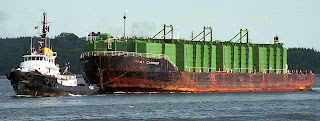I hear that Svitzer Canada Ltd's contract with the Iron Ore Company of Canada in Sept-Iles will not be renewed and that the two tugs stationed there will be sold. It will probably comer as no surprise when we the name of the new owners becomes official. (Hint: they have made other purchases of former Svitzer/Ectugs - in fact almost all former Ectugs).
When the port of Sept-Iles began to ship Labrador iron ore in the early 1950s, it was a very different era. Two factors determined how the ore was carried. First and foremost, there was no St.Lawrence Seaway. Therefore iron ore destined for the Great Lakes was transported by deep sea bulk carriers to Contrecouer, QC and trans-loaded into canallers for the trip to Hamilton. That changed by the late 1950s and when the Seaway opened transhipment was no longer needed, and lakers could load at Sept-Iles and sail directly to steel mils on the lakes.The trade remained seasonal, but the size of ships increased dramatically to 730 foot lakers, displacing the ocean going bulk carriers.
The second factor was the increasing size of ships and the development of specialized bulk carriers. At first most of the Labrador iron ore was exported overseas, and oceangoing bulk carriers grew and grew in size as the 1950s became the 1960s, and Sept-Iles became a year round port for ice strengthened ships.
The Foundation Company of Canada's tug operation, Foundation Maritime was involved with Sept-Iles from the early days in in 1956 and 1958 they built two tugs to service the port, seasonally. In 1961 a third tug arrived in 1961 to serve Baie-Comeau and Sept-Iles as needed. Remarkably all three of those tugs are still in service:
Foundation Victor (1956) now McNally's
Jerry Newberry, laid up and for sale at Port Hawksbury;
Foundation Valour (1958) now
Point Valour and in active service for Thunder Bay Tug Services in Thunder Bay, ON, and
Foundation Vibert (1961) now McKeil's
Florence M., and also very much operational.
The tugs were built with a three tier deckhouse to give skippers a better view over the deck of large ships. This distinctive feature made those three tugs unique in their day.
As winter navigation became a reality by the 1970s more powerful icebreaking tugs were necessary and two new tugs were ordered for Sept-Iles from Collingwoood Shipbuilding. The tugs were contracted to the Iron Ore Company of Canada, although they were free to do other work if not needed by IOC.
Foundation Maritime had sold out to MIL Tug, but the company was on the market. Smit + Cory International had arrived in Canada to operate tugs at Point Tupper and Come-by-Chance, NL and they formed Eastern Canada Towing (ECTUG). So it was Ectug that took delivery of
Pointe aux Basques in 1972
and
Pointe Marguerite in 1973. At 4300 bhp from two 12 cylinder GMs driving twin controllable pitch, open screws and with icebreaking hulls, they were the most powerful tugs in Eastern Canada.
[As an aside, it is interesting that nearby Quebec Cartier Mining in Port Cartier, acquired new tugs at the same time. Now Arcelormittal, they are still operating Brochu and Vachon, both 3600 bhp Voith-Schneiders. They are sisters in all but funnel design to Pointe-Comeau, operated by Svitzer in Baie-Comeau]
1. Pointe Marguerite on the slip in Dartmouth shows off her icebreaking bow. Irving Birch is on the adjacent slip, confusing the look of the tug. March 6, 1977.
A tragic accident on November 14, 1978 saw
Pointe Marguerite crushed between the laker
Algobay and the Italian bulker
Cielo Blanco (88,785 deadweight tons). The tug sank immediately and two men were lost.
2. Pointe-Margureite alongside the Ectug dock in Halifax, March 20, 1977, with Point Vigour (now McKeil's Molly M 1 ) tied up astern and the oil rig Sedco H in the background.
Ectug ordered a replacement from Collingwood, and it was built to essentially the same design. Delivered in 1980 it was named
Pointe Sept-Iles. It was christened by no less than Mila Mulroney wife of the then President of the IOC (and later Prime Minister of Canada, Brian Mulroney.)
3. Pointe Sept-Iles in Wijsmuller colours, June 19, 2001, after Cory (and Ectug) were purchased by the Dutch company.
The tugs have a made a few notable salvage tows through ice in the Gulf and on to Halifax, but they have generally remained in the Sept-Iles area. In the 1970s they came to Halifax for drydocking, but in more recent years at Verreault's shipyard in Méchins.
4. and 5. Pointe Sept-Iles (top) and Pointe aux Basquers (bottom) in the current Svitzer livery, July 6, 2011 at Sept-Iles.
Now it seems that the tugs (which are getting very old in the tooth) will be sold and Svitzer Canada will no longer be represented in Sept-Iles. Groupe Océan has had new 5,000 bhp ice class tugs in Sept-Iles for two years handling the ships at Pointe-Noire and the transshipment to larger bulkers in the bay, and will now have the port to themselves.Most lakers loading iron ore do not need tugs, since they are equipped with thrusters, and ASD tugs have become the world standard for harbour work -able to push and pull with equal power, and twin screw tugs are now relegated to line haul work.The new owners do a lot of that kind of work, so the tugs should have many more years of service.
.




























